Poznan Guide
1 Travel tips
Here are a few things to bear in mind during your stay in Poznan - Avoid taking a taxi straight from the taxi rank. Calling for one will cost a…
Read more »2 Getting to Poznan
Above: The paint job is slicker than the service Below: Poznan's Main StationBy air Poznan Lawica is located around 8km from the city centre…
Read more »3 Getting around Poznan
Above: Fancy a near death experience? Below: Mean green machineBy public transportation The public transport system in and around Poznan is…
Read more »4 Money Matters
Use not as widespread as Western Europe, but rapidly gaining popularity. Some hotels and shops are switching to plastic now so look out for the…
Read more »5 Language
There's no getting away from it - Polish is a tough language, any early attempts at which will have you sounding like you're whispering, gargling and…
Read more »6 Info about Poznan & Poland
Poznan stands as one of Poland's main trading places and is becoming a popular destination for people in search of a city break. Situated to the west…
Read more »About the guide
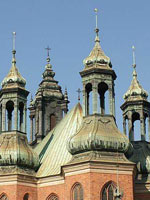 Above: The spires of St. Peter and Paul
Below: Nazguls used to ride those...
Above: The spires of St. Peter and Paul
Below: Nazguls used to ride those...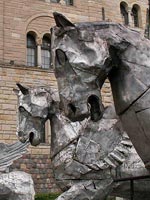
Ok, so Poznan isn't the first place on most people's travel agenda, but those who come here are pleasantly surprised. Its rich history and vibrant night life provide a perfect setting for a city break. The city boasts a wide ranging array of museums, beautiful churches and impressive architecture all linked by way of cobbled, lively streets. Close to the centre are some historical and nicely landscaped open spaces like Citadela, Chopin Park and Ogrody, whilst a little further out you can find some natural and man-made lakes such as Malta, Rusalka and Kiekrz, where in summer locals and tourists go for a whole host of activities and events.
Poznan is known for the numerous annual trade fairs that have been held here since the 1930's, but it's not just business around here though; a large proportion of the population are students, which makes the atmosphere in the bars and on the streets youthful and lively.
Historically, Poznan's beginnings go back to the 9th century when the island of Ostrow Tumski was founded. The cathedral was built in 968 following the establishment of the bishopric and the baptism of the nation. Poland's first king, Boleslaw Chobry, reigned from here through an attack from the Holy Roman Empire in 1005. In 1038, after Poznan sustained heavy damages from Bohemian Prince Bratislav and his army, Krakow was favoured as the place for the throne.
Through the next six centuries trade flourished in the city and the Jesuit School and Lubranski Academy were founded, but in the 17th century, after a series of Swedish, Prussian and Russian invasions, Poznan fell under Prussian occupation. Throughout the late 19th century Poznan, or Posen as it was known at the time, was developed industrially and colonised by the Germans. The Insurrection in 1918 freed Poznan from German occupation, only to be taken again during World War II. The battle for Poznan's liberation in 1945 was costly and lasted an entire month. More recently, the workers' strike in 1956 was a bloody affair which sparked similar protests across the Eastern Bloc and helped to eventually overcome Communist Rule in the region.
Comments
A friend who travelled round Poland said that Poznan was the cleanest, smartest city in Poland. Apparently even more prosperous than Krakow. The old Prussian influence being evident in the cleanliness. I hear the Rynek is amazing. Looking forward to my trip!
ReplyPoznan is a great city - but changing and getting more expensive rapidly so go as soon as you can. Theatre(Opera and Musical eg my Fair Lady in Polish) are great as are the weekly orchestral concerts at the university. It also feels a very safe city and you can still get a bowl of spaghetti bolognese for 50p in one of the many pasta cafes. Just GO!
Reply
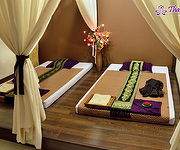 Thai Smile
Thai Smile
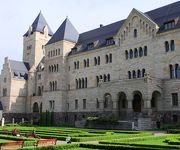 ZAMEK Culture Centre
ZAMEK Culture Centre
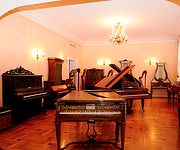 Museum of Musical Instruments
Museum of Musical Instruments